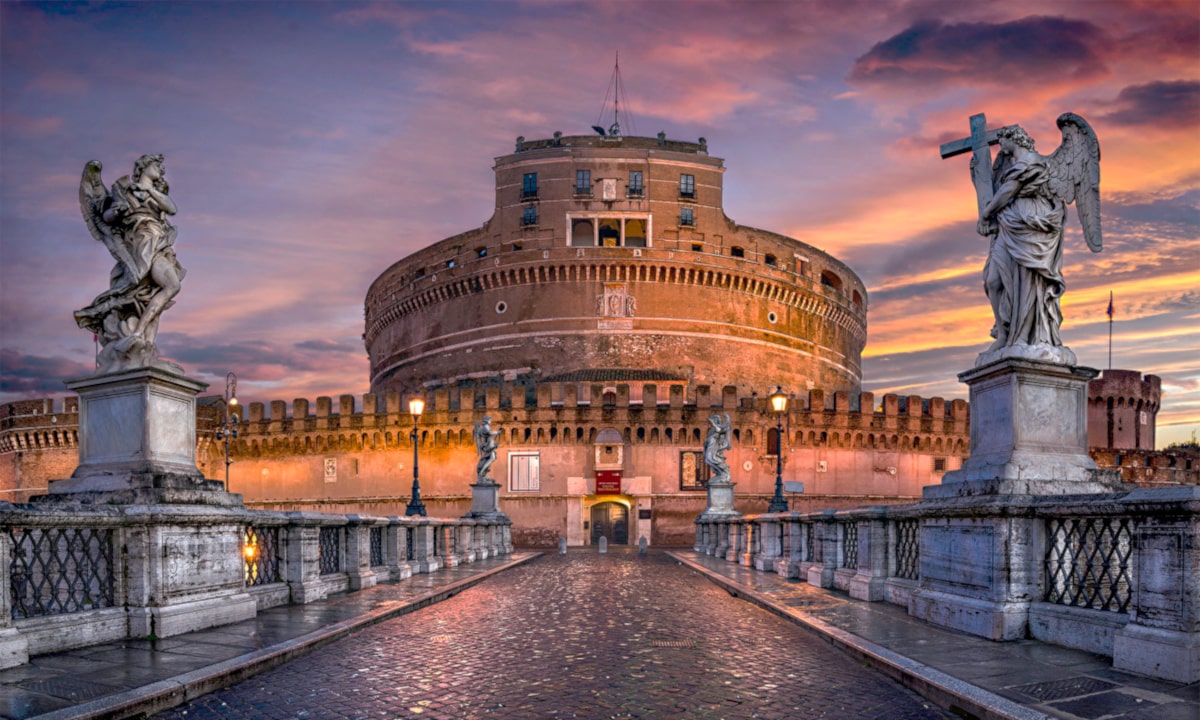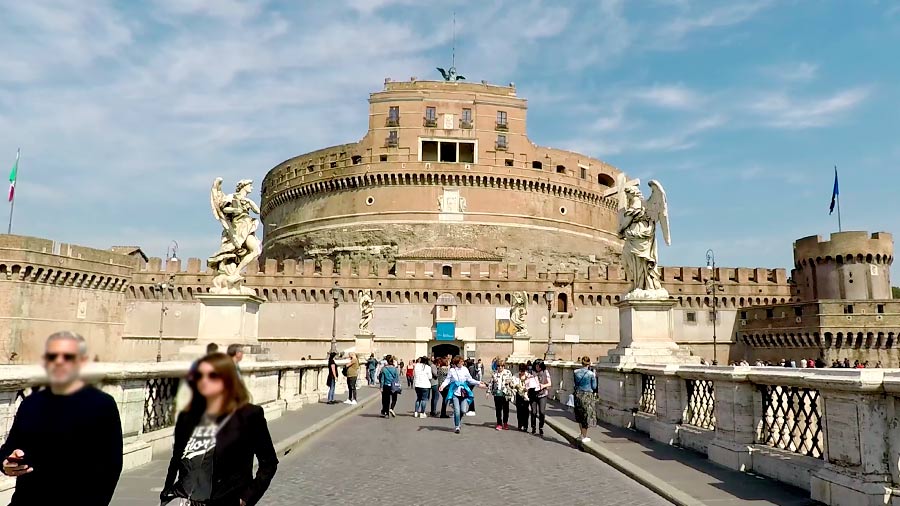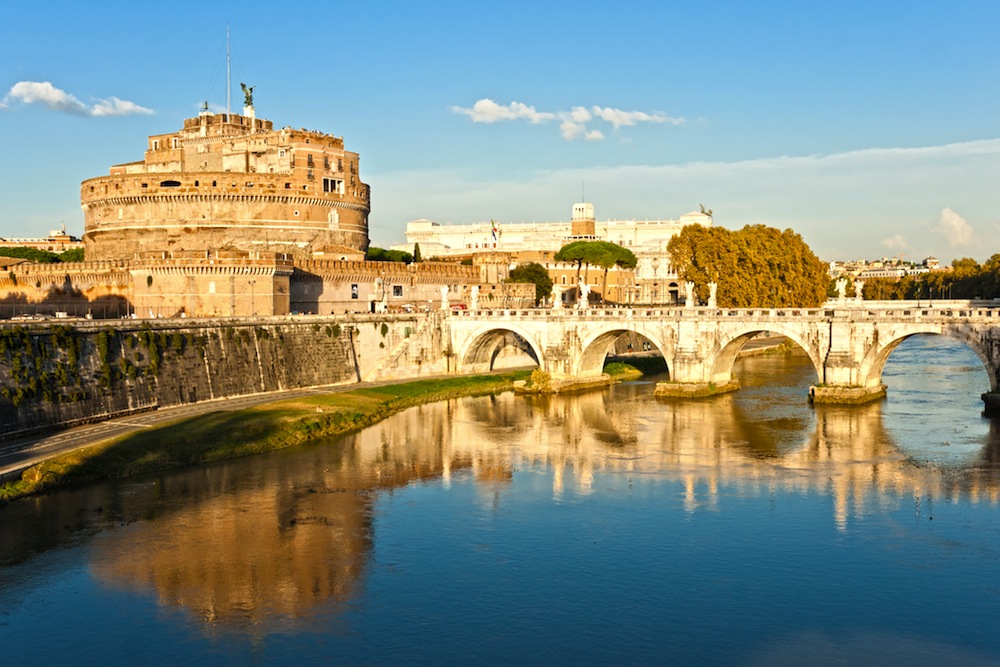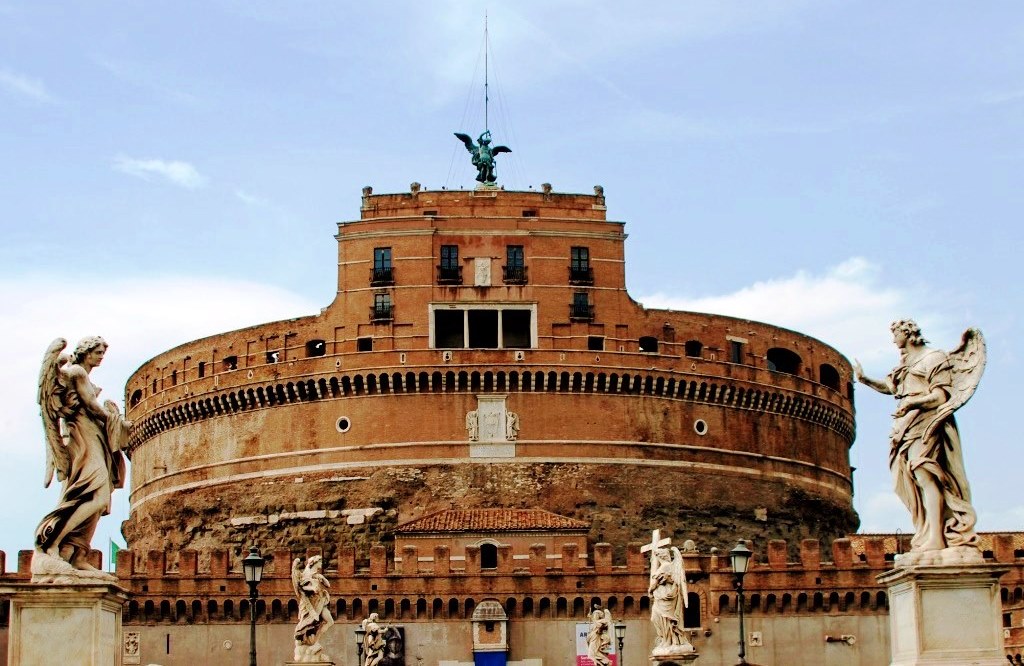
people standing in front of an old building with statues on the outside
El imponente Castillo Sant'Angelo (Castel Sant'Angelo) es el único edificio que ha seguido el desarrollo de la ciudad de Roma por alrededor de 2000 años, los otros monumentos romanos han tenido destinos diferentes, algunos fueron reducidos a ruinas y otros fueron utilizados como canteras para recoger materiales y reciclarlos en nuevas construcci.

El Castillo Sant'Angelo de Roma Italia 🥇
Built as the tomb of the mighty Emperor Hadrian, the Castel Sant'Angelo has seen an astonishing amount of bloodshed, turbulence, and change in the millennia since. From fleeing popes and secret passages to executions and medieval prisons: the Castel Sant'Angelo takes up a fascinating place in Rome's history.

How to visit Castel Sant'Angelo, Rome, and why you shouldn't miss it
El Castillo de Sant'Angelo (en italiano Castel Sant'Angelo) también conocido como «Mausoleo Adriano», fue concebido y construido como el mausoleo personal del emperador Adriano, hacia el año 139 d.C., pero a través de la historia ha cumplido diferentes funciones: fortaleza militar, refugio y residencias Papales, prisión, y en nuestros días Museo.

Castillo Sant'Angelo en Roma
El Castillo de Sant'Angelo (también conocido como el Mausoleo de Adriano o Mole Adrianorum) surgió por voluntad del emperador Publio Elio Traiano Adriano (76 - 138 d.C.) como mausoleo fúnebre para él mismo y para sus sucesores.

Castillo de Sant'Angelo en Roma 148 opiniones y 462 fotos
¿Qué es el Castillo de Sant'Angelo? El Castillo de Sant'Angelo de Roma se construyó originalmente como tumba del emperador romano Adriano en el año 135 d.C. Este mausoleo se convirtió finalmente en una fortaleza militar que protegió a Roma durante la Edad Media.

Visitar el Castillo Sant'Angelo datos prácticos La Maleta de Carla
In breve. Edificato intorno al 123 d.C. come sepolcro per l'imperatore Adriano e la sua famiglia, Castel Sant'Angelo ha un destino atipico nel panorama storico-artistico della capitale. Mentre tutti gli altri monumenti di epoca romana vengono travolti, ridotti a rovine o a cave di materiali di spoglio da riciclare in nuovi, moderni edifici, il.

Castillo de Sant'Angelo. Historia e información
Lungotevere Castello 50, 00193 Rome Italy. Frocked priests, colorful Swiss Guards, insistent souvenir shop owners, flag-waving tour guides, and pilgrims from around the world. This is the Vatican and Borgo, Rome's most recognized neighborhood which acts as Vatican City's front yard. Aside from the souvenir boutiques and a few food spots, the.

Castillo de Sant'Angelo de Roma Los Viajes de Grimes
Reduced ticket€ 7,50. EU citizens 18-24 years. Free ticket€ 5,50. Children: 0-17 years. Rate includes entrance ticket + 4,00 euro skip-the-lne service and reservation on line fees. No ticket required for children under 3 years. Eventual temporary exhibition extra charges are automatically calculated in the on-line price.

Castillo de Sant'Angelo en Roma, precio, visitas, horarios y dirección
Hadrian built the 1200 year old bridge leading to Castle Sant'Angelo for quick, easy, and regal access from central Rome to his tomb. It was originally called the Bridge of Hadrian. But it's name was changed in 1669, when the 10 Bernini-designed angels were added. The three middle arches are Roman originals.

Castillo de Sant'Angelo. Historia e información
Visiting Castel Sant'Angelo. The castle is open Tuesday through Sunday from 9 a.m. — 7:30 p.m. Admission to Castel Sant'Angelo costs €19 for adults and €3.50 for children 17 and under. It's best to arrive earlier in the morning so that you can avoid the crowds, as with many other sites in Rome.

Tour por el Castillo de Sant'Angelo de Roma con subida a terraza
Conocido como Mausoleo de Adriano, el Castillo Sant'Angelo es una fortaleza situada en el margen derecho del río Tíber, a escasa distancia de la Ciudad del Vaticano. Reservar tour Un poco de historia

Visita Castillo de Sant' Angelo Excursiones a Roma
History of Castel Sant'Angelo. The Castel Sant'Angelo was built in the 2nd century as a mausoleum by order of emperor Hadrian. The mausoleum did not become associated with the name of archangel Michael until 590, when Pope Gregory I saw archangel Michael sheathe his sword on top of the mausoleum during a plague to signal the end of the epidemic.

Castillo Sant´Angelo mausoleo, prisión y pasadizos secretos Roma
Chimalpahin Quauhtlehuanitzin, Domingo de San Antón Muñón. Chimalpahin's Conquest: A Nahua Historian's Rewriting of Francisco López de Gómara's La conquista de México. Translated and edited by Susan Schroeder, Anne J. Cruz, Cristián Roa-de-la-Carrera, and David E. Tavárez. Stanford: Stanford University Press, 2010.

castelsantangelo
La historia compleja y estratificada del monumento, relacionada con los tres núcleos principales formados por los vestigios romanos del mausoleo imperial, el castillo fortificado y los apartamentos papales, constituye al mismo tiempo sustancia y marco del recorrido de la exposición, que cuenta con colecciones heterogéneas de esculturas, pinturas.

Pin on Andadas
3 Location Lungotevere Castello, 50. Schedule Price Also known as the Mausoleum of Hadrian, the Castel Sant'Angelo is a fortress located on the right bank of the river Tiber, not far from the Vatican.

Una mirada al Castillo de San Angelo en RomaItalia YouTube
Museo Nazionale di Castel Sant'Angelo Lungotevere Castello, 50 00193 Roma, Italia tel. 39 066819111 e-mail: [email protected] (prenotazione gruppi).